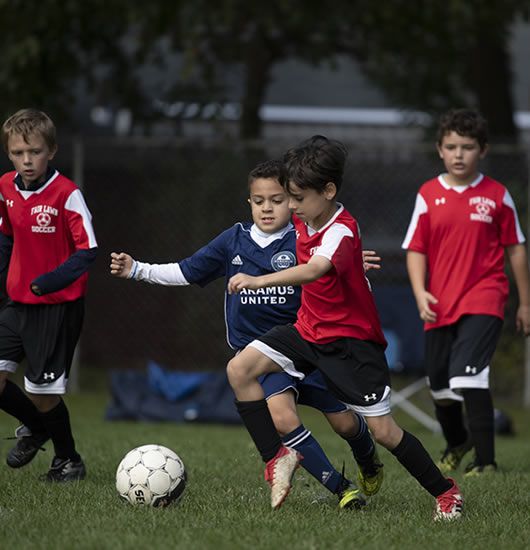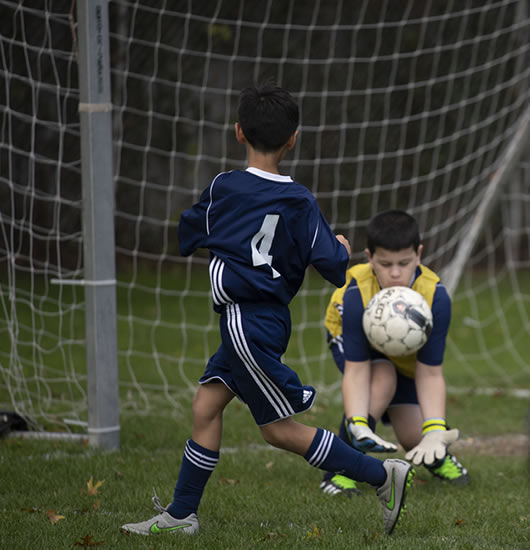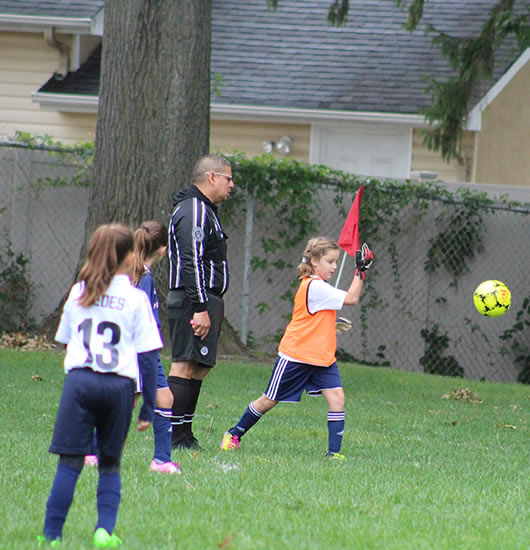Principles of Development
The following principles provide us with guidelines to create an effective long-term structure for developing youth soccer players. In addition to enhancing the youth soccer environment on Paramus, these principles create a foundation for sustainable future growth.
Accumulation of Hours & Number of Touches
Research suggests that it takes a player 10,000 hours of soccer-specific practice and play to reach high levels of expertise. Currently on Paramus and in the United States generally, our young players are not accumulating anywhere near these number of hours.
The Paramus United Soccer Development Framework focuses on providing players with more soccer opportunities that are tailored to develop the individual, more often. Structured soccer homework, regular skill and juggling evaluations motivate players to train on their own thereby receiving more touches of the ball and reach greater levels of technical proficiency. Particular attention is paid to the balance between soccer-specific deliberate practice (e.g. highly structured coach-led practice) and soccer-specific play (e.g. unstructured backyard soccer) throughout the player’s development.
Early Engagement
Research demonstrates that future professional and collegiate-level players begin playing soccer by the age of five, and that success is related to the accumulated hours of specific soccer training. However, rather than an early specialisation model, the Paramus United Soccer Development Framework promotes an Early Engagement approach. During this period (4-12 years old), soccer-specific play is emphasised to promote guided discovery and develop ‘intelligent’ players.
This approach of channelling early Phases of Competition back onto the individual helps create intrinsic motivation and develops the love for the game. This will drive young players into more deliberate practice and commitment towards excellence at later stages of their development. Elements with the Paramus United Soccer Development Framework also focus on creating physically literate players with the fundamental skills to remain active for life.
Recognizing Developmental Age
The timing and tempo of child maturation varies greatly between individuals during growth. This is described as the difference between chronological and developmental age. Players may be of the same chronological age but differ by two to four years in their developmental age.
The Paramus United Soccer Development Framework encourages coaches to be aware of these individual differences when they design training programs and select players. Late maturers should be given as much attention as early maturers, so that no gifted players drop out or miss out on learning opportunities.
Training Emphasis Periods
The physiological systems of young players grow at different rates and times during development. To reach a players’ genetic potential, different fitness training components need to be emphasised at the correct period during a players’ development. The training periods are never completely shut, but improvement may not be optimal.
The Paramus United Soccer Development Framework is structured to provide periods of soccer-specific training without the distraction of competitive league games or back-to-back tournament play. During this period, players develop the technical and tactical foundations they need to play the game effectively and avoid the development of bad soccer habits.
Soccer Fitness
Due to the need for soccer-specific training and the often small window of coach-player contact, physical training needs to be put into a soccer-specific context (e.g. interval training where players learn to recover from short bursts of speed while maintaining a jog). The Soccer Fitness component of the Framework is designed to create physically well-rounded players who possess the knowledge and physical base to remain injury free.
Soccer Fitness is constructed around the Training Emphasis Periods and Developmental Age principles to ensure that the physical intensity and methods of training are matched to players’ characteristics. This approach will also retain more players in the game as appropriate fitness training is related with reduced drop-out.

Four Pillars Approach
The gradual, progressive development of players is fundamental to their enjoyment, technical competency and retention in the game. Becoming a well-rounded and successful soccer player at the highest levels of competition requires a balance of mental, physical, and emotional factors, all of which must be fostered throughout a young player’s development. The Four Pillars Approach requires an integration of the following elements:
- TECHNICAL SKILL
- TACTICAL UNDERSTANDING
- PHYSICAL FITNESS
- MENTAL & EMOTIONAL QUALITIES
Although priorities will vary during the player’s different phases of maturity, the Four Pillars model provides a basic framework for coaches.
For more information, see our Four Pillars of Development page.
Age Appropriate Games
Progression from 5 to 11-a-side games throughout the players’ development helps fulfil the Four Pillars approach. The greater number of touches in small-sided games at a young age provides more opportunities for technical development and one-on-one situations. It also allows a greater number of games to be played on the same pitch simultaneously, giving all players the chance to play rather than being left on the sidelines and losing interest. Adapting the games and competition to the needs of the players is a key feature of any long term player development program.

Identification and Recruitment
Player development is dynamic and non-linear, and there are multiple pathways that young players may take. The Paramus United Soccer Development Framework aims to provide all players with the skills, knowledge and ability to decide for themselves where, and to what extent, they wish to take their soccer careers.
There are specific events and transitions in a players developmental pathway. The Framework is designed to maximize age-appropriate opportunities for players to participate in and be exposed to different environments in which they can be recognized.
Framework Integration and Alignment
Long-term development depends on an array of stakeholders, including clubs, schools and family and outside coaching. To optimise player development, the Paramus United Soccer Development Framework asks that different clubs and institutions become aligned with each other, so they are mutually supportive, clear in their roles, and aware of how they contribute to player development.
Coaches should not deter players who participate in other programs seeking additional training in a competitive environment as long as it doesn’t effect the dynamics of the current team. Likewise, clubs that have a clearly defined mission to develop competitive players should have specific programs for competitive development or clearly delineated training environments that cater to non-competitive players so that all players are able to maximize and enjoy their experience.
Coaching Education and Flexibility
Players will best develop in a coordinated system that is clearly defined and based upon consistent principles. Throughout their soccer career, players (and their parents) will be able to identify the opportunities available to them and understand the pathway they need to follow, whether their aim is excellence, personal improvement or recreational activity.
The Paramus United Soccer Development Framework is underpinned by recent academic research and best practices from leading soccer nations. Youth soccer is rapidly expanding in North America. The principles of youth development are dynamic and constantly growing. Paramus United Soccer Academy will drive ongoing coaching education and will promote a greater knowledge and understanding of youth development. Paramus United Soccer Academy coaching staff will continue to take advantage of opportunities to learn and remain flexible to adapt to different methods and principles of coaching that have been proven to be successful internationally.

